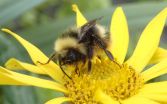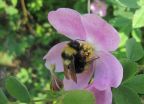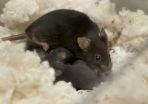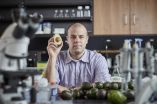(Press-News.org) There is little information about bee populations in Alaska, where native bee pollination is critical to the maintenance of subarctic ecosystems. A team from the University of Alaska Fairbanks and the USDA have now completed a two-year study on bumble bees in agricultural areas in the region. The research was published in the Biodiversity Data Journal.
Pollination is one of the most fundamental processes sustaining agricultural production and natural ecosystems. While decrease in bee populations is a common concern, most press coverage has been directed towards Colony Collapse Disorder or CCD. This is a phenomenon that affects commercially managed honeybees.
However, wild native pollinators, such as bumble bees, are perhaps even more important for the crops.
Alaskan bumble bees, for example, are so well adapted to their environment that they have been observed in temperatures as cold as -3.6°C during snowfall, during the night, and above the tree line. Many of the berries, nuts, and seeds consumed by birds, mammals, and other insects are also a result of bumble bee pollination of native woody and herbaceous plants.
There is a real need to monitor bumble bee populations in North America to assess how their populations are faring and if conservation actions are needed. Alaska, the last frontier, is no exception.
The new survey represents the first multi-year study on bumble bees from the main agricultural areas of Alaska to provide baseline data on species composition, distribution, seasonal biology, and parasites of the bumble bee genus Bombus.
Disturbing trends have been identified in populations of the western bumble bee, Bombus occidentalis. Once considered to be one of the most common west coast bumble bee species, it is now declining in the Pacific Northwest. In Alaska, however, it was collected from all three sites and represented roughly 10% of the total specimens, suggesting that B. occidentalis is a relatively abundant species in the areas studied.
Unfortunately, B. occidentalis specimens tested positive for Nosema - a microsporidian parasite linked to recent catastrophic declines throughout North America in the western bumble bee. Social parasites as well as nematodes were also documented in our survey.
"This report provides baseline data needed to help understand reported patterns of bumble bee declines in North America," explains the lead author Dr. Rehanon Pampell. "Additional research is needed to better understand the biology, geographical distribution, contribution of bumble bees to Alaska agriculture, and the possible effects of endo- and social parasites on bumble bees in the state," she insisted.
INFORMATION:
Additional Information:
Funding for this research was provided by the United States Department of Agriculture, Agriculture Research Service, Subarctic Agricultural Research Unit.
Original source:
Pampell R, Sikes D, Pantoja A, Holloway P, Knight C, Ranft R (2015) Bumble Bees (Hymenoptera: Apidae: Bombus spp.) of Interior Alaska: Species Composition, Distribution, Seasonal Biology, and Parasites. Biodiversity Data Journal 3: e5085. doi: 10.3897/BDJ.3.e5085
Recent genomic research has prompted a petition that calls for the reclassification of African elephants from one threatened species to two endangered species to protect both from imminent extinction.
The U.S. Fish and Wildlife Service (FSW) has 90 days to respond to a petition from the Center for Biological Diversity at http://www.biologicaldiversity.org, a public interest environmental organization dedicated to the protection of native species and their habitats. The Center requests that the FWS recognize the forest elephant (Loxodonta cyclotis) and savannah elephant ...
A strain of bacteria that "breathes" uranium may hold the key to cleaning up polluted groundwater at sites where uranium ore was processed to make nuclear weapons.
A team of Rutgers University scientists and collaborators discovered the bacteria in soil at an old uranium ore mill in Rifle, Colorado, almost 200 miles west of Denver. The site is one of nine such mills in Colorado used during the heyday of nuclear weapons production.
The research is part of a U.S. Department of Energy program to see if microorganisms can lock up uranium that leached into the soil years ...
Zinc plays an important role in a woman's ability to successfully breast-feed her child, according to health researchers.
It has long been known that zinc, an essential trace element, is passed to infants through mother's breast milk. The levels of zinc in mother's milk and the effects of zinc deficiency in infants have been previously studied, but the role of zinc in breast development and function in lactating mothers is a relatively new area of research.
The protein ZnT2 transports zinc in specific tissues in the body, including the mammary glands. Shannon L. Kelleher ...
This news release is available in German. ETH material engineers found that the performance of ion-conducting ceramic membranes that are so important in industry depends largely on their strain and buckling profiles. For the first time, scientists can now selectively manipulate the buckling profile, and thus the physical properties, allowing new technical applications of these membranes.
"Ionics, ion-based data processing and energy conversion, is the electronics of the future", says Jennifer Rupp, a professor of Electrochemical Materials at ETH Zurich, and therewith ...
WASHINGTON, D.C. - The high seas of Mars may never have existed, according to a new study that looks at two opposite climate scenarios of early Mars and suggests that a cold and icy planet billions of years ago better explains water drainage and erosion features seen on the planet today.
For decades, researchers have debated the climate history of Mars and how the planet's early climate led to the many water-carved channels seen today. The idea that 3 to 4 billion years ago Mars was once warm, wet and Earth-like with a northern sea -- conditions that could have led ...
Researchers who paired Siamese fighting fish in mock fights found that winning fish could supply more energy to their muscles during fights than losing fish.
The findings link the invisible processes going on inside cells to tangible consequences in the visible world, and they show how a behavior such as aggression can be affected by underlying biochemical processes that help sustain an animal's life.
"Conspicuous adaptations like antlers are usually what come to mind when thinking about traits that maximize success in aggressive interactions, but as these interactions ...
Rich, creamy, nutritious and now cancer fighting. New research reveals that molecules derived from avocados could be effective in treating a form of cancer.
Professor Paul Spagnuolo from the University of Waterloo has discovered a lipid in avocados that combats acute myeloid leukemia (AML) by targeting the root of the disease - leukemia stem cells. Worldwide, there are few drug treatments available to patients that target leukemia stem cells.
AML is a devastating disease and proves fatal within five years for 90 per cent of seniors over age 65. Spagnuolo's new avocado-derived ...
The world's first study into the brain anatomy of a marine reptile that lived at the same time as the dinosaurs sheds light on how the reptilian brain adapted to life in the oceans.
The fossils of ichthyosaurs, which lived 150 to 200 million years ago, are often very well preserved, but they are commonly flattened. Now investigators have used computed tomography to create a 3-D scan of the animal's skull, revealing internal details of the palate and braincase that usually cannot be seen. A reconstruction of the brain shows the importance of vision for the predator, which ...
In a new study, older women who lived in places with higher air pollution had significantly reduced white matter in the brain. For the study, a research team took brain MRIs of 1403 women who were 71 to 89 years old and used residential histories and air monitoring data to estimate their exposure to air pollution in the previous 6 to 7 years.
The findings suggest that ambient particulate air pollutants may have a deleterious effect on brain aging.
"Investigating the impact of air pollution on the human brain is a new area of environmental neurosciences. Our study provides ...
The prevalence of smoking among undergraduate nursing and physiotherapy students in Spain decreased from 29.3% in 2003 to 18.2% in 2013. Many of the students remained unaware of the link between smoking and diseases such as bladder cancer or the negative health effects of second-hand smoke, which points to a significant deficiency in undergraduate training.
The majority of nursing and physiotherapy students recognized that healthcare professionals were role models in society, noted Dr. Beatriz Ordás, lead author of the Journal of Advanced Nursing study.
INFORMATION: ...






